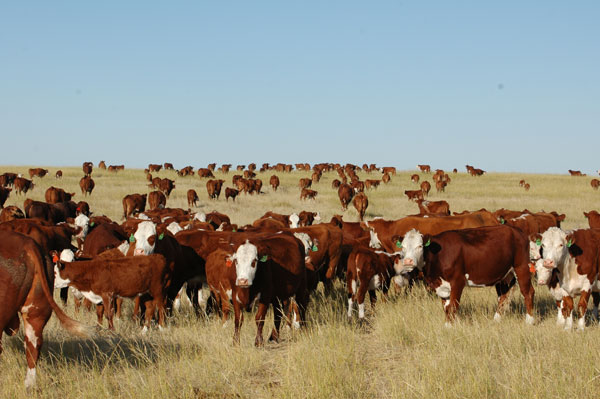September 14, 2015

Fueled by the most abundant forage in two decades, the total U.S. cattle inventory was 2% larger than last year — at 98.4 million head on July 1, according to the semiannual Cattle Inventory Report from USDA. That’s in comparison with an upward revision to last year’s number. This was the first increase in July-to-July numbers since 2006.
There were 3% more beef cows — 30.5 million head total — than the previous year. There were 7% more beef replacement heifers (4.9 million head total).
“This year will be the second consecutive year of significant increases in heifers being developed for breeding herds and sets the stage for further herd growth, mainly of beef-type heifers over 500 pounds,” according to analysts with the Livestock Marketing Information Center (LMIC).
“It is an evolving picture that will depend on conditions in the coming years, but at the current time my estimate is that the industry will operate with around 32.0 to 32.5 million beef cows,” says Derrell Peel, Oklahoma State University Extension livestock marketing specialist. “It appears that we could achieve that level at the earliest by 2017, more likely by 2018 or 2019.”

18 photos show ranchers hard at work on the farm
Readers have submitted photos of hard-working ranchers caring for their livestock and being stewards of the land. See reader favorite photos here.
“The initial growth phase will be relatively quick, and will flatten out,” says Don Close, Rabobank Food & Agribusiness Research and Advisory (FAR) group senior analyst. “We are going to see the process happen in two phases and in different geographies than we would have a few years ago. The excess capacity in the Southwest and High Plains will fill out first. Once that area has repopulated, rebuilding will occur in the central U.S. — mainly the Dakotas and into the Corn Belt.”
Close and fellow senior analyst Sterling Liddell coauthored the recent Rabobank report, Beef Cow Repopulation: The Case for Diversification. The report projects the geographic distribution of the U.S. beef cow herd to be more geographically concentrated in the next four to six years.
“The combination of the repopulation in areas of the Southwest and High Plains to conventional levels, plus the addition of confined and semi-confined cow-calf units in the row crop-producing regions of the central U.S., will lead to a unified, central states cowherd,” Close says.
“Once this repopulation is completed, the beef cowherd will have returned to near 2011 levels,” Liddell explains. “Although it will depend on factors such as exports and weather, I expect a total of 3.5 to 4.0 million head more than the 2014 low of 29 million beef cows. Of that total, 1.7 million head will come from newly developed capacity in the central U.S. — areas typically focused on row-crop production.”
Subscribe now to Cow-Calf Weekly to get the latest industry research and information in your inbox every Friday!
So, figure 32.5 million beef cows, give or take about 500,000 head, by 2019 or so (2018-2020). That’s a faster pace than key projections issued when the year began.
The 2015 U.S. Baseline Briefing Book from the Food and Agricultural Policy Research Institute (FAPRI) at the University of Missouri pegged peak beef cow numbers by 2024 at 31.3 million head in 2019. USDA Agricultural Projections to 2024 estimated 32.6 million beef cows in 2020, peaking at 33.7 million in 2024.
Taking a broader view of the inventory, LMIC projects the total U.S. cattle inventory next Jan. 1 at 92.4 million head, which would be 3% more year over year. LMIC analysts note that the national cattle inventory increased four times since 1967, with each expansion phase lasting three to eight years.
How much expansion the business needs now depends on lots of factors besides Mother Nature, including domestic and international demand as well as total beef production.
“Per capita beef consumption will grow as beef production expands, but demand will determine at what price level this consumption will occur,” Peel explains. “In a stable market, consumers will pay a price just high enough for a given level of consumption to ensure that producers will provide enough beef for that level of consumption.”
You might also like:
70 photos honor the hardworking cowboys on the ranch
Chipotle facing lawsuit for GMO-free claims
Will beef demand keep up with cowherd expansion?
Why you shouldn't feed your cows like steers in a feedlot
What's the best time to castrate calves? Vets agree the earlier the better
You May Also Like



